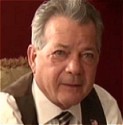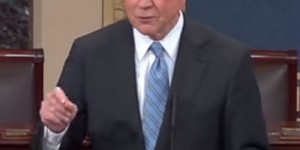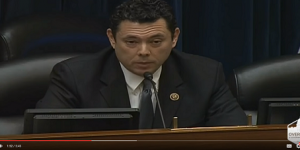It’s easy to call Minuteman Project founder Jim Gilchrist of Aliso Viejo a frothmouthed racist agitator, especially if you ignore a few inconvenient truths.
by Steven M. Thomas
Assumption No. 1
Jim Gilchrist is nothing but a shameless self-promoter. Gilchrist is a Rhode Island native who has been married to his wife, Sandy, for 14 years. They have two grown stepdaughters. He says his rise to the forefront of the immigration issue began in the 1990s, when he and Sandy wrote to Sens. Barbara Boxer and Dianne Feinstein, and their congressman, Christopher Cox, on a regular basis, demanding action on the problem of illegal immigration. They were concerned about the use of taxpayer dollars to provide services for non-citizens and the government’s failure to enforce the laws of the land. “All we ever got back were boilerplate replies from the politicians that [didn’t] address the issue,” he says.
The issue took on new urgency for Gilchrist after the events of Sept. 11, 2001. Outraged that most of the Saudi attackers were in the country illegally, having overstayed their visas, Gilchrist blamed the federal government for allowing the tragedy to happen. Deciding to get more involved, he says he “started reading everything I could find on the subject and doing a lot of research.” The Minuteman Project, which Gilchrist describes as a multiethnic immigration law enforcement advocacy group, was born Oct. 1, 2004, when he stayed up all night composing an e-mail recruitment poster inviting people to join him on the Mexican border. “Within two weeks, that e-mail ended up in 400,000 mailboxes,” he says.
Gilchrist crossed the border of American consciousness six months later, on April 1, 2005, when he and his followers set up camp in the desert south of Tombstone, Ariz., to draw attention to the problem of uncontrolled illegal immigration from Mexico into the United States. “I knew if I could create the largest gathering of Minutemen since the Revolutionary War that it would have an impact on the issue,” he says. During the next 35 days, more than 1,000 people from around the country participated in the controversial event, fanning out along a 24-mile stretch of the international border to look for and report undocumented immigrants slipping into the country. The gathering sparked a media frenzy, drew a charge of vigilantism from President Bush, and probably did more than any other single event to push immigration reform to the center of the American political stage. In the three years since then, Gilchrist has stayed relevant by advocating strict border control and immigration-law enforcement in city council meetings, on college campuses, at border events, and on more than 2,500 television and radio shows. His energetic agitation has helped make immigration one of the top issues in the 2008 presidential election season.
Gilchrist also jumped into politics directly, running for Congress as an American Independent and campaigning for candidates who support his views. The run for Congress made him look good. After a whirlwind three-month campaign in fall 2005, he attracted a respectable 25.8 percent of the vote in a special election to fill the 48th District congressional seat vacated when Cox was appointed chairman of the federal Securities and Exchange Commission. Republican John Campbell won the election, but Gilchrist says, “I had a big smile on my face … the day after the election. There were four bills dealing with immigration chaos introduced in Congress that day. Ten weeks before, none of them were in the works. I have to give myself some credit for that.” Others give him credit as well. “Gilchrist was very effective in exploiting talk radio to make illegal immigration a hot issue in the congressional campaign,” says Michael Capaldi, chairman emeritus of Orange County’s iconic Lincoln Club, a nationally influential group of Republican moneymen and power brokers. Adds Mark Petracca, chairman of the political science department at the University of California, Irvine, “Gilchrist’s run for Congress in the open primary election probably compelled the other candidates in this and other local and county elections to focus more on immigration than would have been the case absent his candidacy.” Local political blogs lit up recently with speculation that Gilchrist aims to unseat Democratic U.S. Rep. Loretta Sanchez in the 47th district in November, a rumor he doesn’t deny. “There’s a 50-50 chance I’ll get in,” he says. If he does, it’s a safe bet that furious protesters will show up at every campaign stop accusing him of being a hateful nativist marching arm-in-arm with the Ku Klux Klan and the Aryan Nation to trample the rights of Mexican immigrants.
Assumption No. 2
Jim Gilchrist is a froth-mouthed racist agitator masquerading as a reasonable man. As Gilchrist sips coffee and explains what he stands for, the flaws in my assumptions jump out at me. A decorated Marine veteran who volunteered to fight in Vietnam when he was 18, arriving in Quang Tri province near Khe Sanh in February 1968 at the tail end of the Tet offensive, Gilchrist is passionately anti-war, viewing the Iraq conflict as a terrible mistake. He is a registered Republican, but considers George W. Bush the worst president in American history. He expresses strong and seemingly sincere support for multiculturalism, noting that one of his stepdaughters is married to a Mexican-American man and two of his grandchildren are half- Mexican. He points out that the Minuteman Project itself is a multiracial and multiethnic group with African-Americans and Hispanics in positions of leadership. “We have individuals who have immigrated here legally from countries like Cuba, Mexico, and Peru who help Jim,” says Robin Hvidston, a college-educated mother and housewife who is Gilchrist’s national rally organizer. “It is not a matter of race. It is a matter of upholding laws.”
Another surprise comes when he tells me that his border patrols were never intended to actually stop illegal immigration. “That first border event was a dog-and-pony show,” he says. “It was political activism. I organized it to draw attention to the failure of the government to secure our borders, and it did that in spades. Patrolling the border is only about 5 or 10 percent of what the Minuteman Project is about. The other 90 to 95 percent is driving this issue up through city councils, mayors, state legislatures, and governors into the halls of Congress to force change.” As he talks, I’m struck by the reasonableness of many of his views on immigration. He is passionate about “the rule of law” in American life and history, and believes that free flowing illegal immigration and a failure to deal with illegal immigrants tend to undermine the nation’s civic foundations. A retired certified public accountant with three college degrees, he has a good grasp of numbers and makes effective points about the extent of illegal immigration, as well as its economic and social consequences.
Some of his harshest scorn is reserved for big corporations and other businesses that employ undocumented workers. “Enforcement against employers is key,” he says. “These big companies are engaged in a 21stcentury slave trade, luring poor people north to work for dirt cheap wages and no benefits to increase their profits. They are laughing all the way to the bank while hard-working citizens are crying all the way to the poorhouse. If you come here impoverished and work for $8 an hour as a carpenter, low wages keep you in poverty while you put a $40-an-hour union carpenter out of work, and [then] we have twice as much poverty as before.” Other of Gilchrist’s positions are arguable. He says he supports legal immigration but only for people “who have integrity and character that will preserve us as a civilized nation governed under the rule of law.” It’s not clear who, exactly, would gaze into the eyes of each potential immigrant and divine whether they have a good heart or a bad one. Gilchrist also advocates deporting undocumented people already in the country. The federal government says there are 12 million of them in the United States, while Gilchrist puts the number at 30 million. Either way, the idea of mustering the political will and practical ability to find all those people, pluck them out of the social fabric, and expel them from the country seems like a fantasy.
When I ask Gilchrist if he really believes it is possible, he talks about arresting employers to make examples of them, cutting off welfare services, building a $6 billion wall along the entire U.S.-Mexico border, and hiring more border guards, immigration investigators, prosecutors, and judges to handle deportations. “It’ll take time,” he says. “You have to educate the public, which is what I am trying to do. We don’t live in a perfect, ideal society, and we never will, but somewhere between that ideal and the way it is, there is a practical reality we can reach.” Morning blends into afternoon as we talk. Workers and high school students on lunch break crowd into the coffee shop. Several people stop to greet Gilchrist — an Afghan immigrant, a sheriff’s deputy, and an elderly white woman, among others. “I saw your picture in the paper,” the woman says, patting his shoulder. “I am for you. I support what you are trying to do.”
Assumption No. 3
But seriously, he really is a froth-mouthed, hatemongering racist agitator underneath it all, right? The last thing I wanted to do was defend this guy and then have someone send me a video clip of him uncorking his inner Lester Maddox. So I got to work conducting numerous interviews and doing extensive research to see if I could find the Maddox clip myself. The first thing I discovered was that Jim Gilchrist is a hard subject to get a handle on. There are an infinite number of bloggy accusations against him, and an equal number of hateful anti- Mexican rants in defense of him and his positions. Most, on both sides, are devoid of good grammar and supporting evidence. In the realm of verifiable reality, I interviewed serious people — academics, activists, and political observers — and listened to those who say Gilchrist is a monster, as well as those who say he is a great American. I also met with Gilchrist on the patio of the same Starbucks for another long conversation, spoke to him frequently on the phone, and exchanged numerous emails with him. He was always accessible and forthcoming with any information I requested. In the end, I decided Gilchrist is partly responsible for many of his problems. He has an unfortunate penchant for militarist metaphor. To him, the illegal immigration problem is “a Trojan Horse invasion” and “the number of illegals crossing the border each week is equivalent to four reinforced army divisions.” That kind of talk inflames his opponents and makes it easy for them to think him inclined to violence.
Though Gilchrist often shows remarkable forbearance when under personal attack, he reacts in the long run with considerable hostility toward those who denigrate him, hurling back in print and on air the charges of racism and rotten behavior his critics aim at him, vowing to defeat and dismantle their organizations. Understandable, but not a great public relations strategy. It doesn’t help that he sometimes sounds apocalyptic, talking about illegal immigration leading to the breakup of the country along racial and ethnic lines “like the old Soviet Union.” Probably the biggest source of the animosity and confusion surrounding him stems from the cause itself.
While Gilchrist seems sincere about his desire for non-violence and racial tolerance, the anti-immigration debate attracts many lowlifes whose words and behavior get charged to him although he has never met them and doesn’t sanction their acts. He says there are more than 200 independent groups that use the word “minuteman” in their title that have nothing to do with his Minuteman Project. He is regularly called to account for the actions of others. On the other side, talking with Gilchrist’s opponents, reading what they write, and watching their tactics on video, has been no less disturbing — and at times has made me ashamed to consider myself a liberal. Remarkably uninformed, they pour bile on him like pitch from the ramparts. They accuse him of murder, mental illness, cowardice, criminality, scapegoating, and nativism — the politically correct term du jour for racism — but offer scant proof of their charges.
Assumption No. 4
Jim Gilchrist is an insignificant pipsqueak who has done little more than throw gasoline on the fire. Gilchrist is never more controversial than when he takes his message onto college and university campuses. In October 2006, he was invited to speak about immigration reform at Columbia University. When he stepped to the lectern, students organized by Hispanic campus groups stormed the stage, knocked over the lectern and drove Gilchrist into the wings. Columbia University President Lee Bollinger, not exactly an apologist for the right wing, condemned Columbia students for silencing Gilchrist, calling the preplanned disruption “one of the most serious breaches of academic faith that can occur in a university such as ours.”
David Eisenbach, who teaches media and politics at Columbia, remembers the repercussions that followed. “Columbia was bashed in just about every publication in New York City, from the New York Post to the New York Times, for not being able to carry out its duty to ensure free speech,” he says. “It was shameful the way the event erupted into fisticuffs.” Eisenbach adds that when he tried to bring Gilchrist back to the campus for the one-year anniversary of the disrupted speech, socialist and Hispanic student groups blocked the event. A year later, in November 2007, students invited Gilchrist to debate the immigration issue at California State University, Long Beach. Other students and professors banded together to form the Campus Coalition Against Hate in response, condemning Gilchrist by the very title of their organization. They organized a counter-rally and refused to debate him, citing the Columbia incident as evidence that he was “looking to provoke” conflict and violence. Enrique Morones, a San Diego immigrant-rights activist, eventually agreed to debate Gilchrist at Cal State Long Beach, but then, after insisting that he be allowed to speak first, launched into a 10-minute series of personal attacks, accusing several people not present who he said were connected with Gilchrist of being child molesters and criminals, and then saying that Gilchrist himself is mentally ill, has a criminal record, and was the laughingstock of the Marine Corps when he was fighting in Vietnam. Morones then led a planned walkout of students opposed to Gilchrist who had packed the auditorium. Gilchrist stayed calm, saying only that Morones was lying. Someone shouted that those leaving the auditorium were liberal scum, but Gilchrist hushed his supporter. “They are not liberal scum,” he said. “They are just uninformed.” He then gave a two-hour talk mostly about the importance of the First Amendment to the 50 or 60 students who remained. When I asked Morones afterward for evidence to back up his charges, he seemed outraged that I questioned his truthfulness — but did not provide a scrap of proof.
Norma Chinchilla, chairwoman of the Chicano and Latino Studies Department and one of the leaders of the Campus Coalition Against Hate at Long Beach, offers another reason why she declined to debate Gilchrist. “I don’t consider him a major voice in the immigration debate,” she says, concurring with Victor M. Rodriquez, a professor in her department. “Who is James Gilchrist?” Rodriquez asks. “He is not an expert on immigration.” Convenient if true, but plenty of others see Gilchrist as a leading player. Republican presidential candidate Mike Huckabee, the former Arkansas governor, consulted with Gilchrist on his immigration policy and solicited his endorsement last fall, trumpeting it on the front page of his campaign Web site and on “Larry King Live” when Gilchrist endorsed him in December. “No one can question Jim’s commitment to this country and the immigration problem,” Huckabee says. A number of polls conducted by network and cable news organizations in 2005 and 2006 show that a solid majority of Republicans support Gilchrist’s Minuteman Project.
A 2005 Rasmussen Survey of 1,000 adults found that 54 percent of all Americans had a favorable opinion of the Minutemen. Adds Michael Capaldi of the Lincoln Club: “No one else on the anti-illegal immigration side has had the impact that he has. Gilchrist knows how to light the bonfires and keep them burning. He’s a voice that you can’t ignore.” Still, Chinchilla calls Gilchrist an extremist who is operating outside the political mainstream and who needlessly showed up for the Long Beach debate wearing a bullet-proof vest outside his suit coat. Gilchrist, who has a penchant for political theater, says he wore the vest to help engage students in a discussion about the dangers of speaking out on controversial subjects and the importance of the First Amendment. Professors Chinchilla and Rodriquez say the vest was a melodramatic provocation, proof that Gilchrist is a troublemaker. Their reaction, of course, ignores the fact that members of the anti-Gilchrist group showed up with tape over their mouths and bandanas hiding their faces.
A few weeks after the uproar at Cal State Long Beach, a Gilchrist appearance at Long Beach City College was canceled for security reasons. Byron D. Breland, that college’s dean of student affairs, insists the decision was not driven by a political agenda. The cumulative result, arguably, was that the students who disrupted and protested Gilchrist at Columbia and Cal State Long Beach helped silence him at City College. In one sense, the attitude of people such as Chinchilla and Rodriquez toward Gilchrist is wholly understandable. There is a long, ugly history of anti-Latino racism in California and the United States, and racism persists today. But that protective attitude can easily go too far. History is full of oppressed people who later become repressive themselves. “People around here try to suppress everything like we are a communist school or something,” says Cal State Long Beach junior Jason Aula, the student leader who invited Gilchrist to campus. “It is like you are not free to have an opposing viewpoint. But we are not going to be intimidated by people. Illegal immigration is not a Democrat or Republican issue. It is an American issue, and we have a right to express and maintain our side of that issue in a respectful, non-racist way. That is what America is about.”
Assumption No. 5
Jim Gilchrist must somehow be getting rich, as well as famous, from all this. Gilchrist serves as president of the Minuteman Project without pay, takes no reimbursement for car or phone expenses, and has borrowed against his home to tide the organization over when expenses outpaced donations, loaning as much as $70,000 of his own money to the cause. He receives a steady stream of death threats, some of which are posted on his Web site under the heading “Hate Mail.” He says his windshield has been smashed and his car keyed. So why does he do it?
Chinchilla believes he likes the limelight: “I think he has just latched onto an issue that he can get some response on,” she says. Ted Hayes, a Los Angeles homeless advocate, disagrees, insisting that Gilchrist is “motivated by love for country.” Gilchrist, a self-professed “Navy brat” who attended nine schools before graduating from high school, says he joined the Marine Corps right out of high school because he wanted to defend his country. He knows now that the Gulf of Tonkin incident was bogus and believes the Vietnam War was a mistake, but the urge to serve is still there. He knows how difficult it is to force change in the face of entrenched interests, but believes he is making a difference. “Jim Gilchrist came along at a time in my life when I felt very alone and believed that nobody knew what was going on and nobody cared,” says Barbara March, mother of David March, a Los Angeles County sheriff’s deputy who was killed by an illegal immigrant gang member who fled to Mexico to avoid prosecution. “He is a hero who is trying to help his country.” Gilchrist named his first camp at the border Camp David March to honor the slain deputy. “That touched us so deeply,” says John March, David’s father. “Our goal has always been to make Dave’s life and death count. As a result of the awareness the Minuteman Project brought to the border, and of what my wife, and I, and others have done, all of a sudden Mexico has had to change its extradition policy. Dozens of killers of U.S. citizens have already been extradited back to the United States. Politicians are now starting to talk seriously about securing our border. Jim Gilchrist was instrumental in that monumental change.”
Gilchrist says he doesn’t enjoy the constant conflict in his life, but isn’t surprised at the hostility directed at him. Despite the trials and turmoil, he says he will continue until he gets the results he wants — or someone comes along to take his place. Talking about Vietnam, as he often does, Gilchrist says, “I think about that place every day, more than once a day. I mostly remember it as a very tragic place. I have some good memories of my experience there, too, and I wouldn’t trade my tour of duty for a million dollars. But I wouldn’t do it again for a billion.”
In the end, he may look back on his immigration activism in the same way. And the Easiest Assumption Of All? Jim Gilchrist is a crook. Jim Gilchrist’s image took a hard hit when several of his close associates tried to take over the Minuteman Project early in 2007. The group accused him of stealing donated money and announced that they had fired him as head of the organization. Guy Mailly, Gilchrist’s attorney, calls the takeover attempt “so silly on its face that it is incredible. Jim is the founder of the Minuteman Project. He has never relinquished control of the organization. He was the sole member of the board of directors and is still the sole member of the board of directors.” In addition, Gilchrist controls the Web site www.minutemanproject.com and continues to function as the group’s leader and spokesman in high-profile appearances on national television and with national political candidates.
Still, the charges were widely and uncritically reported around the county and country. A civil trial in Orange County Superior Court in May should settle outstanding issues, but so far the process has seemed to vindicate Gilchrist and raise questions about the validity of the charges against him. Among those questions:
1. The Minuteman Project was incorporated by Gilchrist in Delaware with Gilchrist as the sole member of the board of directors. How did his associates have the authority to fire him as president of the organization?
2. Why did Orange County Superior Court Judge Randell Wilkinson issue an injunction in March 2007, barring the takeover group from using the Minuteman Project name, spending the organization’s money, or doing fundraising under its guise?
3. If Gilchrist was embezzling, why was he never arrested or charged with a crime, and why is he so willing to make available a certified audit of the Minuteman Project’s finances during the period in question?
4. Why has the takeover group been cut loose by several attorneys in succession — most recently by the law firm of Gilbert & Marlowe, which sent a letter Nov. 1, 2007, describing a communications breakdown, asking the takeover group to sign a substitution of attorney form, and threatening legal action against the group?
———–
Steven M. Thomas is a writer based in Orange.
All Rights Reserved © 2008 – Orange Coast Magazine




























